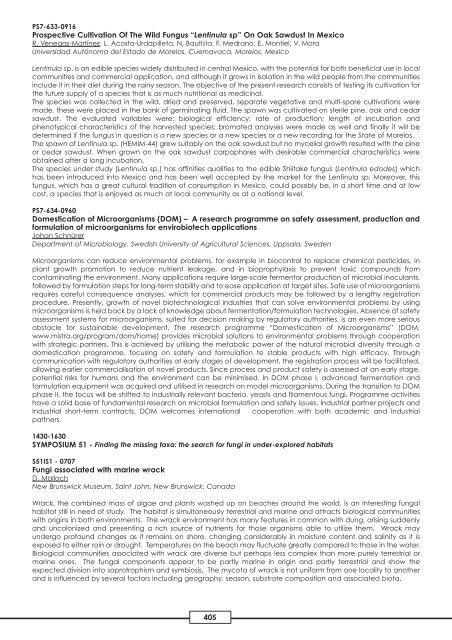Handbook Part 2 - International Mycological Association
Handbook Part 2 - International Mycological Association
Handbook Part 2 - International Mycological Association
You also want an ePaper? Increase the reach of your titles
YUMPU automatically turns print PDFs into web optimized ePapers that Google loves.
PS7-633-0916<br />
Prospective Cultivation Of The Wild Fungus “Lentinula sp” On Oak Sawdust In Mexico<br />
R. Venegas-Martínez, L. Acosta-Urdapilleta, N. Bautista, F. Medrano, E. Montiel, V. Mora<br />
Universidad Autónoma del Estado de Morelos, Cuernavaca, Morelos, Mexico<br />
Lentinula sp. is an edible species widely distributed in central Mexico, with the potential for both beneficial use in local<br />
communities and commercial application, and although it grows in isolation in the wild people from the communities<br />
include it in their diet during the rainy season. The objective of the present research consists of testing its cultivation for<br />
the future supply of a species that is as much nutritional as medicinal.<br />
The species was collected in the wild, dried and preserved, separate vegetative and multi-spore cultivations were<br />
made, these were placed in the bank of germinating fluid. The spawn was cultivated on sterile pine, oak and cedar<br />
sawdust. The evaluated variables were: biological efficiency; rate of production; length of incubation and<br />
phenotypical characteristics of the harvested species; bromated analyses were made as well and finally it will be<br />
determined if the fungus in question is a new species or a new species or a new recording for the State of Morelos.<br />
The spawn of Lentinula sp. (HEMIM-44) grew suitably on the oak sawdust but no mycelial growth resulted with the pine<br />
or cedar sawdust. When grown on the oak sawdust carpophores with desirable commercial characteristics were<br />
obtained after a long incubation.<br />
The species under study (Lentinula sp.) has affinities qualities to the edible Shiitake fungus (Lentinula edodes) which<br />
has been introduced into Mexico and has been well accepted by the market for the Lentinula sp. Moreover, this<br />
fungus, which has a great cultural tradition of consumption in Mexico, could possibly be, in a short time and at low<br />
cost, a species that is enjoyed as much at local community as at a national level.<br />
PS7-634-0960<br />
Domestication of Microorganisms (DOM) – A research programme on safety assessment, production and<br />
formulation of microorganisms for envirobiotech applications<br />
Johan Schnürer<br />
Department of Microbiology, Swedish University of Agricultural Sciences, Uppsala, Sweden<br />
Microorganisms can reduce environmental problems, for example in biocontrol to replace chemical pesticides, in<br />
plant growth promotion to reduce nutrient leakage, and in bioprophylaxis to prevent toxic compounds from<br />
contaminating the environment. Many applications require large-scale fermentor production of microbial inoculants,<br />
followed by formulation steps for long-term stability and to ease application at target sites. Safe use of microorganisms<br />
requires careful consequence analyses, which for commercial products may be followed by a lengthy registration<br />
procedure. Presently, growth of novel biotechnological industries that can solve environmental problems by using<br />
microorganisms is held back by a lack of knowledge about fermentation/formulation technologies. Absence of safety<br />
assessment systems for microorganisms, suited for decision making by regulatory authorities, is an even more serious<br />
obstacle for sustainable development. The research programme “Domestication of Microorganisms” (DOM,<br />
www.mistra.org/program/dom/home) provides microbial solutions to environmental problems through cooperation<br />
with strategic partners. This is achieved by utilising the metabolic power of the natural microbial diversity through a<br />
domestication programme, focusing on safety and formulation to stable products with high efficacy. Through<br />
communication with regulatory authorities at early stages of development, the registration process will be facilitated,<br />
allowing earlier commercialisation of novel products. Since process and product safety is assessed at an early stage,<br />
potential risks for humans and the environment can be minimised. In DOM phase I, advanced fermentation and<br />
formulation equipment was acquired and utilised in research on model microorganisms. During the transition to DOM<br />
phase II, the focus will be shifted to industrially relevant bacteria, yeasts and filamentous fungi. Programme activities<br />
have a solid base of fundamental research on microbial formulation and safety issues. Industrial partner projects and<br />
Industrial short-term contracts. DOM welcomes international cooperation with both academic and industrial<br />
partners.<br />
1430-1630<br />
SYMPOSIUM 51 - Finding the missing taxa: the search for fungi in under-explored habitats<br />
S51IS1 - 0707<br />
Fungi associated with marine wrack<br />
D. Malloch<br />
New Brunswick Museum, Saint John, New Brunswick, Canada<br />
Wrack, the combined mass of algae and plants washed up on beaches around the world, is an interesting fungal<br />
habitat still in need of study. The habitat is simultaneously terrestrial and marine and attracts biological communities<br />
with origins in both environments. The wrack environment has many features in common with dung, arising suddenly<br />
and uncolonized and presenting a rich source of nutrients for those organisms able to utilize them. Wrack may<br />
undergo profound changes as it remains on shore, changing considerably in moisture content and salinity as it is<br />
exposed to either rain or drought. Temperatures on the beach may fluctuate greatly compared to those in the water.<br />
Biological communities associated with wrack are diverse but perhaps less complex than more purely terrestrial or<br />
marine ones. The fungal components appear to be partly marine in origin and partly terrestrial and show the<br />
expected division into saprotrophism and symbiosis. The mycota of wrack is not uniform from one locality to another<br />
and is influenced by several factors including geography, season, substrate composition and associated biota.<br />
405









